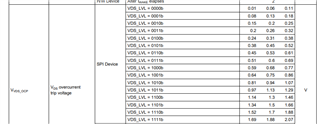Other Parts Discussed in Thread: DRV8343S-Q1EVM
Our customer has questions about DRV8343SPHPRQ1.
<Question>
The overcurrent is detected by the OCP function of the driver IC, but when the power supply of the driver IC drops (voltage enough to generate ULVO), does the overcurrent threshold of internal OCP drop ?
OCP has both VDS_OCP and SEN_OCP set.
<Background of this question>
OCP occurred when the power supplied to the driver IC was momentarily dropped (about 5.5V to 6.5V) during motor evaluation at the customer's site,with a current value that was not the original set current.
UVLO was sometimes occurring when OCP occurred.
This voltage drop was due to the current limitation of their DC power supply, but they wants to know if the voltage drop makes OCP more likely.
<Conditions at the time of occurrence>
OCP occurs when the brushless motor is rotated and the power supply voltage drops to 5.5V to 6.5V.
Power supply voltage: Set value DC14.5V
When the motor rotates, it drops to about 5.5V to 6.5V when the current flows due to phase changing.
FET on resistance:1mohm
Shunt resistance:1mohm
Current value:Peak 70A
VDS_OCP setting value:0.26V
SEN_OCP setting value:0.25V
Please advise us.
Regards,
Kura


